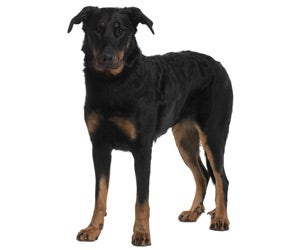Beauceron
-
Overview
Beaucerons are naturally intelligent dogs who have an uncanny ability to remember commands and tasks. They are graceful but also quite large — males can weigh up to 110 pounds and stand at least 2 feet tall. Even though they are about the size and color of Doberman Pinschers, they have a much leaner build. Beaucerons are patient, gentle dogs who flourish with experienced, dominant owners who can respond to their obedient natures. They are intelligent, hard-working dogs who will be happy living in an area with plenty of space for them to exercise.
-
Personality
The Beaucerons' breed standard describes them as frank, and indeed, these large dogs are often deliberate in their actions and their carriage. Although Beaucerons are active, rambunctious puppies who can't be trusted not to make mischief when they are left alone, they grow up into mature, gentle dogs. They are known for responding well to obedience training by developing a quick and thorough understanding of their master's commands and wishes.
Beaucerons are loyal and protective dogs, but if they are properly socialized, they should never be aggressive without provocation. They are known for bonding incredibly closely to one member of their family, to the extent that they lavish most of their affection on the same person and don't respond well to receiving commands from more than one person.
-
Coat Care
The Beaceron's coat comes in either black and tan or harlequin patterns with gray, black and tan markings. Their tan or gray markings are always placed above the eyes, on the bottom of the upper lip and throat, on the breast, under the tail and on the bottom of each leg. Beaucerons never have any white patches. Their hair is shorter and slightly harsh with longer fringes on the tail and around the hindquarters. The under coat is woolly and fluffy enough to insulate the Beauceron in cold temperatures. Their fringed tail is curved in a J-shape.

Brush your Beauceron once a week with a slicker brush to remove dead hair and keep the hair lying close to the body.
Bathe them every couple of months if they start to develop an odor of if you notice that they are shedding more than usual.
Trimming the Beauceron's coat is unnecessary, but it should always have a neat, well-groomed appearance.
Beaucerons have a double declaw on their hind legs, which gives them the appearance of having 6 toes. This does not hurt the dog, but it should not be removed if you plan to show your dog.
Not all breeds and coat styles require routine trimming in and around the eyes and ears but all should undergo regular inspection and cleaning around these sensitive areas. Doing so will help prevent the development of infections that could seriously damage these amazing organs.
It is always important to routinely clean your dog's eyes and ears, and examine for potential infections. Some smooth-coated dogs, like Basenjis and Boxers, and dogs with large ears, like Weimaraners and Great Danes, have sensitive ears that should be checked weekly for infection and cleaned with a cotton ball. Gently wipe a cotton ball moistened with mineral oil, olive oil or witch hazel in your dog's ear, being careful to avoid the ear canal. Never use a Q-Tip, which could cause damage to the inner ear if your dog suddenly shakes or jerks his head. Bushy hair growth within the ear can be thinned with tweezers or blunt scissors. Use a small trimmer to trim excess hair around the eyes, ears and face. If you have a small dog, like an Italian Greyhound, take special care to clean around their eyes with a cotton ball or soft cloth and use a small trimmer to trim excess hair around their eyes to make sure they are comfortable. Dogs with facial wrinkles, like French Bulldogs and Boston Terriers, should have their faces wiped down at least weekly to prevent infection.
Many owners do not realize how important it is to brush your pet’s teeth on a regular basis. Some dogs are prone to dental problems and sensitive teeth, especially small dogs with tiny teeth and dogs with special diets. These problems can be easily combatted with frequent brushing.
Cavities are rare with dogs but gum disease caused by tartar buildup is not, which is why they require regular brushing with toothpaste and a toothbrush formulated specifically for dogs. While daily brushing is ideal, doing so on a weekly basis will be a big help in avoiding the need to bring your dog to a veterinarian for a cleaning, which usually has to be done under sedation.

 India (English)
India (English)
 Middle East and Africa (English)
Middle East and Africa (English)
 South Africa (English)
South Africa (English)
 Australia (English)
Australia (English)
 Japan (日本語)
Japan (日本語)
 South East Asia (English)
South East Asia (English)
 Singapore (English)
Singapore (English)
 Europe (English)
Europe (English)
 United Kingdom (English)
United Kingdom (English)
 Argentina (Español)
Argentina (Español)
 Brazil (Portuguese)
Brazil (Portuguese)
 Colombia (Español)
Colombia (Español)
 Latin America (Español)
Latin America (Español)
 México (Español)
México (Español)
 Chile (Español)
Chile (Español)
 Peru (Español)
Peru (Español)
 Canada (English)
Canada (English)

